
Figure 1: Local anaesthesia


Angelo Rebelo*
Plastic, Reconstructive and Aesthetic Surgery, Clínica Milénio, Rua Manuel Silva Leal, Lisboa, Portugal*Corresponding author: Angelo Rebelo, Plastic, Reconstructive and Aesthetic Surgery, Clínica Milenio, Rua Manuel Silva Leal, Lisboa, Portugal, Tel: + 351 21 7277265; E-mail: clinicamilenio@netcabo.pt
Background: This is a simple and almost risks free technique. Very efficient, improving the appearance of people with herniation of fat pad bags of the lower lids.
Objective: The author reports a series of 3239 blepharoplasty with external mini-incisions from September 1990 through July 2017.
Methods: All patients have a complete clinical history, preoperative routine examinations and photos pre and post-operative. Local anaesthesia is used.
Results: Fat pad bags of the lower lids were removed without major complications or recidive.
Conclusions: This is a simple and quick technique with minimal scars almost invisible, with very good results, quick recovery, few risks and complications.
Blepharoplasty; Mini-incisions; Plastic Surgery
It was Fontana, a Plastic Surgeon from Valenca, Spain, who invented this technique to remove the fat pad bags of the lower lids, through minimal transcutaneous incisions of 2-3 mm. It’s a very simple technique, easy to perform, with indication in cases with excess or herniation of the fat pad bags. We also perform this procedure in patients with skin excess and/or wrinkles, [1-3] with good results. It’s a good alternative to the conjuntival approach [4,5] because it’s more comfortable and with fewer risks to the patients. We verified that the removal of the simple fat pad gives a much better appearance to patients with a good skin retraction and if necessary can be complemented with peeling’s or laser procedures.
Patients Since September of 1990, 3239 blepharoplasty were performed with external mini-incisions. Lo
In our experience the age is not an important factor. We have concluded that the operated patients are very satisfied and with a good result. This technique is excellent in patients with herniation without excess of skin. However we have been performing it, with good results, in patient with certain excess of skin and some wrinkles.
Like other surgical procedures it has the same contraindications.
It is contraindicated when certain ocular diseases occur.
Local anaesthesia, Lydocaine 2% with Adrenaline was used, 4-8 cc (Figures 1a and 1b).

Figure 1: Local anaesthesia
It is performed under local anaesthesia, through a small 2-3 mm incision made with an 11 blade, in the lower lid at pupil level. It should be cut at once, downwards, skin, muscle and septum until the central bag (Figures 2 and 3); pressing, at the same time, the eye to facilitate the extrusion of the fat with the removal of the blade (Figure 4a).
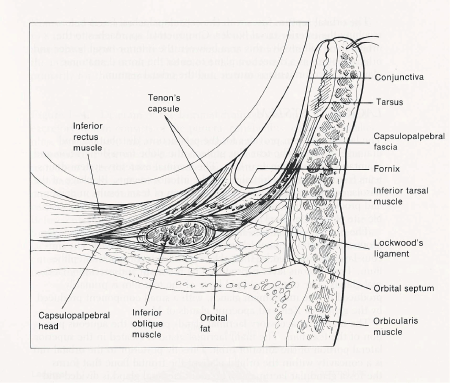
Figure 2: Incision localization
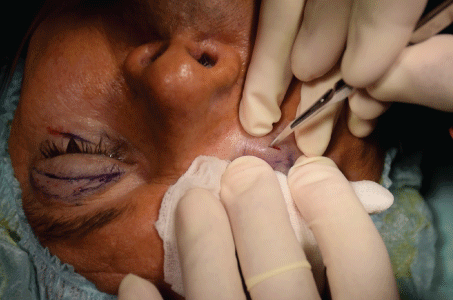
Figure 3: Incision
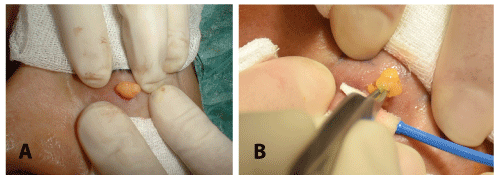
Figure 4: Fat extrusion
With the help of forceps the fat is gently pushed and cut with a cautery high Temperature Loop Tip (Aaron Medical Industries, St. Petersburg, FL) (Figures 4b and 5). We can use electrocautery low intensity, radio surgery or laser.
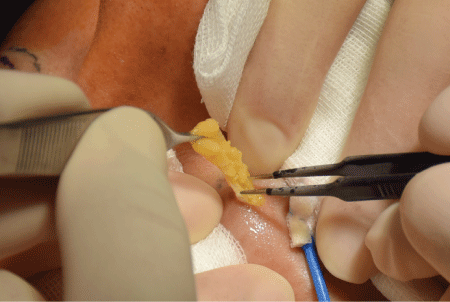
Figure 5: Fat cutting
Through the same small incision we have access to the internal and external fat pad bags. With gentle and directioned movements we should remove sufficient fat, never in excess (Figure 6). Incision closure is carried out with a 6/0 nylon, one or two stitches (Figure 7).
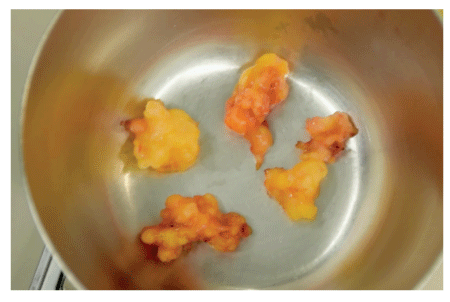
Figure 6: Fat
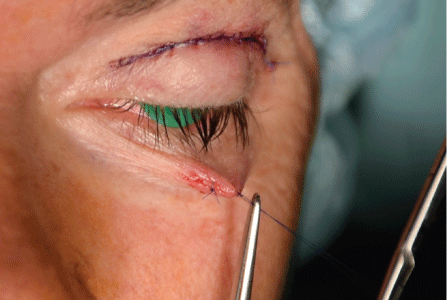
Figure 7: Incision closure
We also performed a similar procedure on the upper lid (Figures 8-13), but with very specific indications of herniation of the medial and internal fat pad bags, through a 2-3 mm incision in the inner portion of the upper lid near the naso-frontal field in a wrinkle with the same steps as for the lower lid.
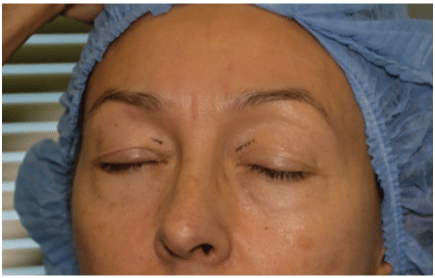
Figure 8: Upper lid localization Upper lid localization
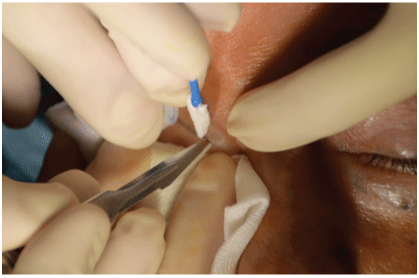
Figure 9: Upper lid incision
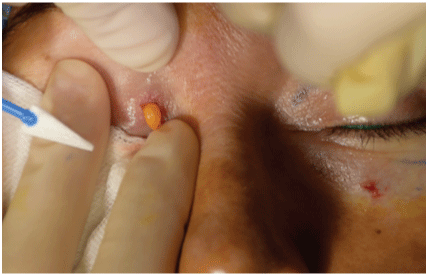
Figure 10: Upper lid fat extrusion
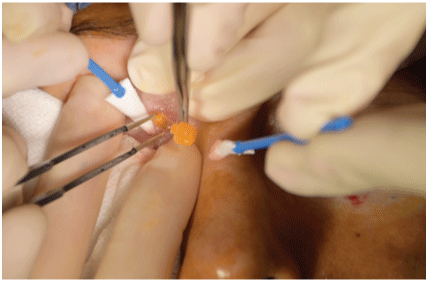
Figure 11: Upper lid fat cutting
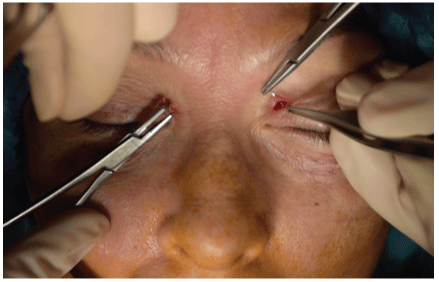
Figure 12: Upper lid incision closure
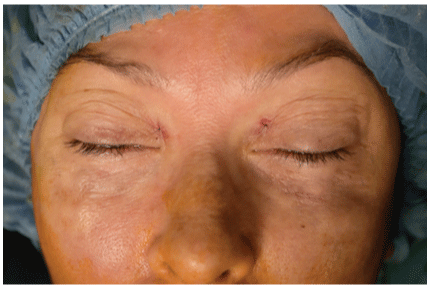
Figure 13: Upper lid final result
No dressing is used. Patients should apply cold compresses several times in the 48-72 hours after the operation.
The stitches should be removed between the 3rd and 6th days. Edema and swelling are much less evident and a quicker recuperation is observed. Sun must be avoided until bruising disappears and they have to apply a sun block cream.
All patients are medicated with antibiotic, anti-inflammatory and analgesic (usually no needed).
They are good to excellent and we can observe precocity in final results, 2-3 weeks. The very small scar disappears in 1-2 weeks.
Never happens complications of eye deformation like “sclera-show”, “round eye” and ectropion.
No infections, visible or hypertrophic scars, seroma or deformities were observed.
Small haematomas may occur and were reported in 3 patients without sequels.
Since September of 1990 we have performed 2947 blepharoplasties with external mini-incisions, without complications. It is a very well tolerated surgery and post-operative, with quicker recovery, and good long term results.
Clinical case A
A patient with the age of 65 years old was treated and shown after 36 months (Figure 14-17).
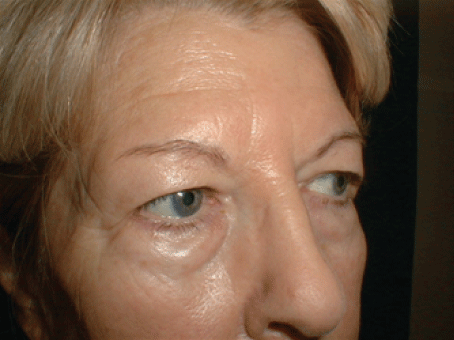
Figure 14: Clinical case A1 pre-operation
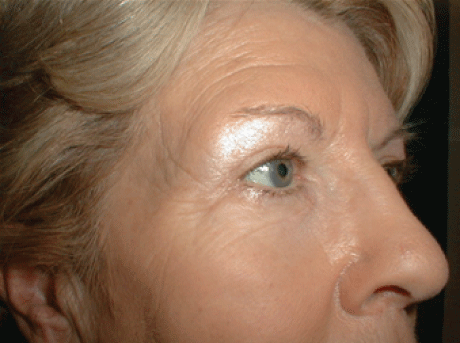
Figure 15: Clinical case A1 post-operation
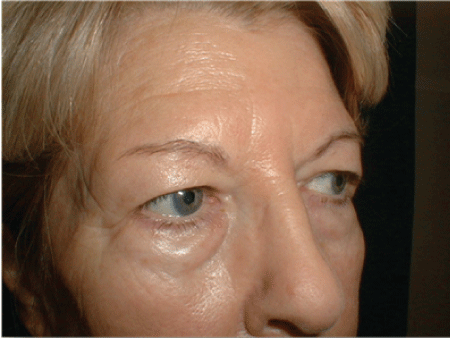
Figure 16: Clinical case A2 pre-operation
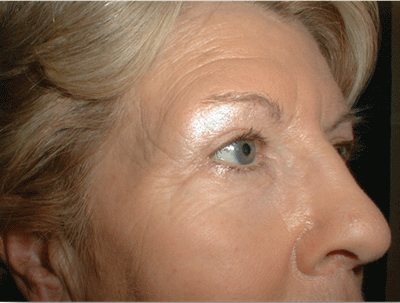
Figure 17: Clinical case A2 post-operation
A patient with the age of 48 years old was treated and shown after 6 months (Figure 18-21).
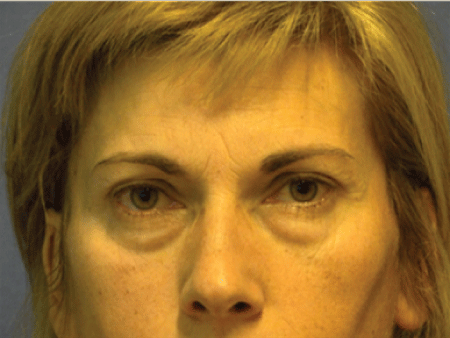
Figure 18: Clinical case B1 pre-operation
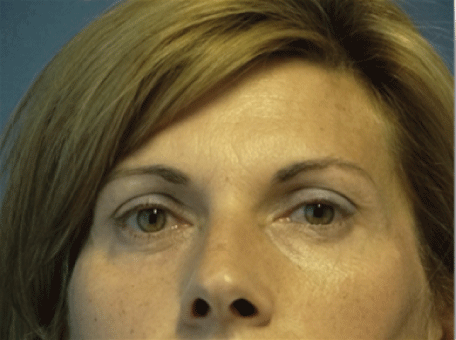
Figure 19: Clinical case B1 post-operation.
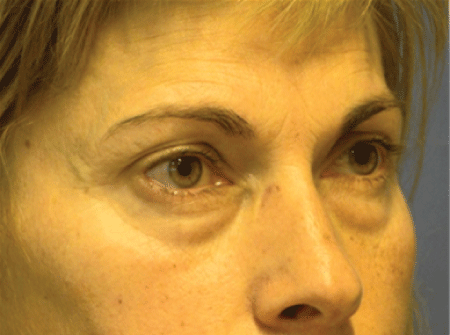
Figure 20: Clinical case B2 pre-operation
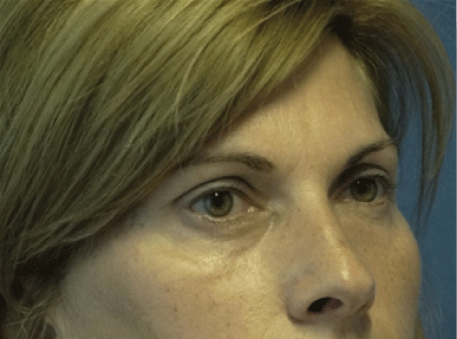
Figure 21: Clinical case B2 post-operation
A patient with the age of 59 years old was treated and shown after 6 months (Figure 22-25).
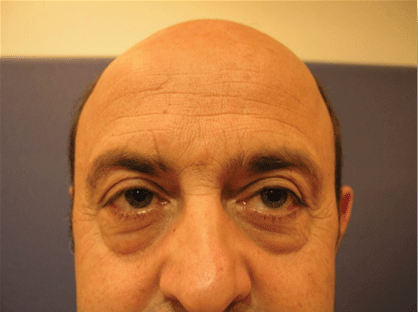
Figure 22: Clinical case C1 pre-operation
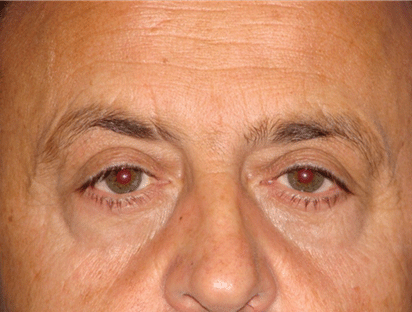
Figure 23: Clinical case C1 post-operation
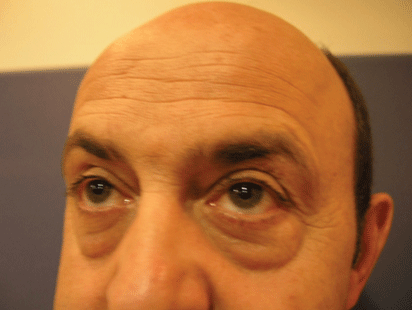
Figure 24: Clinical case C2 pre-operation
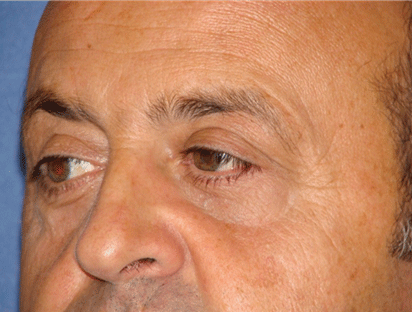
Figure 25: Clinical case C2 post-operation
Download Provisional PDF Here
Aritcle Type: Research Article
Citation: Rebelo A (2017) Blepharoplasty with External Mini-Incisions. J Clin Cosmet Dermatol 1(3): http://dx.doi.org/10.16966/2576-2826.118
Copyright: © 2017 Rebelo A. This is an open-access article distributed under the terms of the Creative Commons Attribution License, which permits unrestricted use, distribution, and reproduction in any medium, provided the original author and source are credited.
Publication history:
All Sci Forschen Journals are Open Access